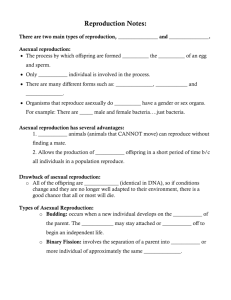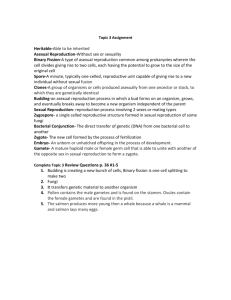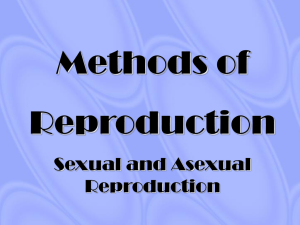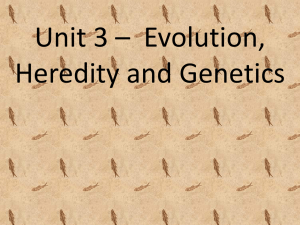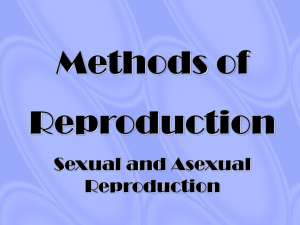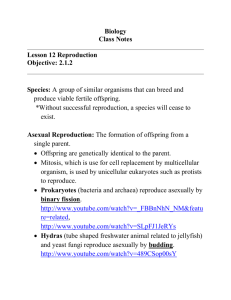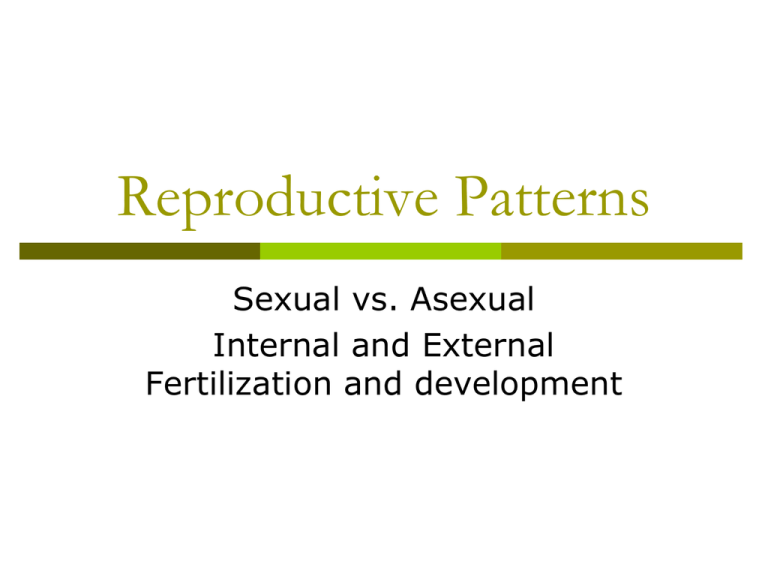
Reproductive Patterns
Sexual vs. Asexual
Internal and External
Fertilization and development
Types of Reproduction
There are two main types of reproduction:
sexual and asexual.
Asexual reproduction:
The process by which offspring are formed
WITHOUT the FUSION of an egg and sperm.
Only ONE individual is involved in the process.
There are many different forms such as:
BUDDING, BINARY FISSION and
FRAGMENTATION.
Organisms that reproduce asexually do NOT have
a gender or sex organs.
For example: There are NOT male and female
bacteria….just bacteria.
Asexual reproduction has several
advantages:
1. SESSILE animals (animals that CANNOT
move) can reproduce without finding a
mate.
2. Allows the production of MANY offspring
in a short period of time because all
individuals in a population reproduce.
Drawback of asexual reproduction:
All of the offspring are CLONES (identical
in DNA), so if conditions change and they
are no longer well adapted to their
environment, there is a good chance that
all or most will die.
Types of Asexual Reproduction:
Budding: occurs
when a new
individual develops
on the SIDE of the
parent. The
OFFSPRING may
stay attached or
FALL off to begin an
independent life.
Types of Asexual Reproduction:
-Binary Fission:
involves the
separation of
a parent into
TWO or more
individuals of
approximately
the same
SIZE.
Types of Asexual Reproduction:
Fragmentation or
Regeneration:
the SPLITTING apart
of an organism into
several pieces.
Each piece re-grows
(regenerates) the
missing parts and
develops into a new
INDIVIDUAL.
Starfish Regeneration
Sexual reproduction:
The process by which offspring are formed by the
fusion of egg and sperm to form a diploid
(contains TWO copies of each chromosome)
ZYGOTE.
FERTILIZATION = fusion of egg and sperm
Offspring receive HALF of their DNA from each
parent.
Offspring are GENETICALLY DIVERSE>
This type of reproduction increases the genetic
diversity of the species. It is ADVANTAGEOUS in
environments that are under constant stress.
Drawbacks of sexual reproduction:
Have to find a
PARTNER
Have to wait until
sexual MATURITY
Not all members of
the population
REPRODUCE
Major Mechanisms of Fertilization:
External Fertilization:
Eggs are shed into the
ENVIRONMENT and fertilized
by the male.
Occurs in moist habitats
where development can occur
without the fear of DRYING
OUT.
The process can occur without
CONTACT between the
parents.
Chemical signals coordinate
the process insuring the
gametes are not WASTED.
Major Mechanisms of Fertilization:
Internal Fertilization:
Occurs when sperm are deposited in or
near the FEMALE reproductive tract and
fertilization occurs INSIDE the female
body.
Requires a more SOPHISTICATED
reproductive system and cooperative
mating behaviors.
Embryo Development
Embryos can develop INTERNALLY or EXTERNALLY.
Internal development means that the embryos develop
INSIDE the body of the mother.
In order for internal development to occur, there had to
have been INTERNAL fertilization.
Animals that follow this development pattern are referred
to as having “LIVE YOUNG”.
Embryos may also develop externally, or OUTSIDE the
body of the mother.
External development may happen after either INTERNAL
or EXTERNAL fertilization.
Embryo Protection
Externally produced
embryos are protected in
several ways:
They may be covered with
a JELLY LAYER which
allows for free gas
exchange with the
environment and provide
the embryo with moisture.
LARGE numbers of
zygotes are produced to
insure that some reach
maturity. (100’s, 1,000’s,
maybe even millions)
Internally produced embryos:
May be protected by an
egg shell, as in reptiles
and birds.
Some are LEATHERY and
some are HARD.
PLACENTAL mammals
retain their offspring in a
special structure called the
uterus.
Internally protected
zygotes have a HIGHER
rate of survival, and
therefore, less ZYGOTES
are produced.


